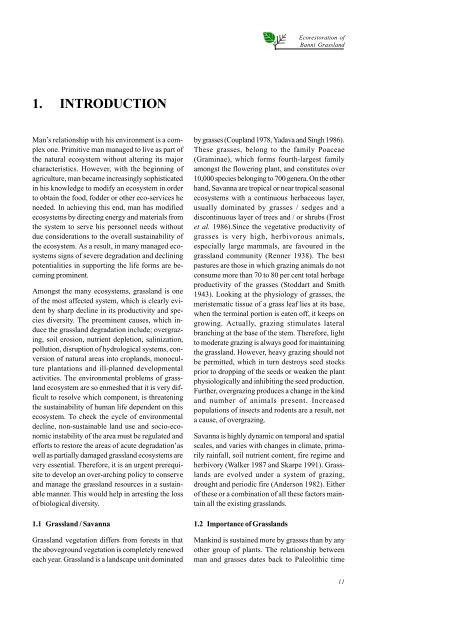Ecorestoration of Banni Grassland - Global Restoration Network
Ecorestoration of Banni Grassland - Global Restoration Network
Ecorestoration of Banni Grassland - Global Restoration Network
You also want an ePaper? Increase the reach of your titles
YUMPU automatically turns print PDFs into web optimized ePapers that Google loves.
1. INTRODUCTION<br />
Man’s relationship with his environment is a complex<br />
one. Primitive man managed to live as part <strong>of</strong><br />
the natural ecosystem without altering its major<br />
characteristics. However, with the beginning <strong>of</strong><br />
agriculture, man became increasingly sophisticated<br />
in his knowledge to modify an ecosystem in order<br />
to obtain the food, fodder or other eco-services he<br />
needed. In achieving this end, man has modified<br />
ecosystems by directing energy and materials from<br />
the system to serve his personnel needs without<br />
due considerations to the overall sustainability <strong>of</strong><br />
the ecosystem. As a result, in many managed ecosystems<br />
signs <strong>of</strong> severe degradation and declining<br />
potentialities in supporting the life forms are becoming<br />
prominent.<br />
Amongst the many ecosystems, grassland is one<br />
<strong>of</strong> the most affected system, which is clearly evident<br />
by sharp decline in its productivity and species<br />
diversity. The preeminent causes, which induce<br />
the grassland degradation include; overgrazing,<br />
soil erosion, nutrient depletion, salinization,<br />
pollution, disruption <strong>of</strong> hydrological systems, conversion<br />
<strong>of</strong> natural areas into croplands, monoculture<br />
plantations and ill-planned developmental<br />
activities. The environmental problems <strong>of</strong> grassland<br />
ecosystem are so enmeshed that it is very difficult<br />
to resolve which component, is threatening<br />
the sustainability <strong>of</strong> human life dependent on this<br />
ecosystem. To check the cycle <strong>of</strong> environmental<br />
decline, non-sustainable land use and socio-economic<br />
instability <strong>of</strong> the area must be regulated and<br />
efforts to restore the areas <strong>of</strong> acute degradation’as<br />
well as partially damaged grassland ecosystems are<br />
very essential. Therefore, it is an urgent prerequisite<br />
to develop an over-arching policy to conserve<br />
and manage the grassland resources in a sustainable<br />
manner. This would help in arresting the loss<br />
<strong>of</strong> biological diversity.<br />
1.1 <strong>Grassland</strong> / Savanna<br />
<strong>Grassland</strong> vegetation differs from forests in that<br />
the aboveground vegetation is completely renewed<br />
each year. <strong>Grassland</strong> is a landscape unit dominated<br />
<strong>Ecorestoration</strong> <strong>of</strong><br />
<strong>Banni</strong> <strong>Grassland</strong><br />
by grasses (Coupland 1978, Yadava and Singh 1986).<br />
These grasses, belong to the family Poaceae<br />
(Graminae), which forms fourth-largest family<br />
amongst the flowering plant, and constitutes over<br />
10,000 species belonging to 700 genera. On the other<br />
hand, Savanna are tropical or near tropical seasonal<br />
ecosystems with a continuous herbaceous layer,<br />
usually dominated by grasses / sedges and a<br />
discontinuous layer <strong>of</strong> trees and / or shrubs (Frost<br />
et al. 1986).Since the vegetative productivity <strong>of</strong><br />
grasses is very high, herbivorous animals,<br />
especially large mammals, are favoured in the<br />
grassland community (Renner 1938). The best<br />
pastures are those in which grazing animals do not<br />
consume more than 70 to 80 per cent total herbage<br />
productivity <strong>of</strong> the grasses (Stoddart and Smith<br />
1943). Looking at the physiology <strong>of</strong> grasses, the<br />
meristematic tissue <strong>of</strong> a grass leaf lies at its base,<br />
when the terminal portion is eaten <strong>of</strong>f, it keeps on<br />
growing. Actually, grazing stimulates lateral<br />
branching at the base <strong>of</strong> the stem. Therefore, light<br />
to moderate grazing is always good for maintaining<br />
the grassland. However, heavy grazing should not<br />
be permitted, which in turn destroys seed stocks<br />
prior to dropping <strong>of</strong> the seeds or weaken the plant<br />
physiologically and inhibiting the seed production.<br />
Further, overgrazing produces a change in the kind<br />
and number <strong>of</strong> animals present. Increased<br />
populations <strong>of</strong> insects and rodents are a result, not<br />
a cause, <strong>of</strong> overgrazing.<br />
Savanna is highly dynamic on temporal and spatial<br />
scales, and varies with changes in climate, primarily<br />
rainfall, soil nutrient content, fire regime and<br />
herbivory (Walker 1987 and Skarpe 1991). <strong>Grassland</strong>s<br />
are evolved under a system <strong>of</strong> grazing,<br />
drought and periodic fire (Anderson 1982). Either<br />
<strong>of</strong> these or a combination <strong>of</strong> all these factors maintain<br />
all the existing grasslands.<br />
1.2 Importance <strong>of</strong> <strong>Grassland</strong>s<br />
Mankind is sustained more by grasses than by any<br />
other group <strong>of</strong> plants. The relationship between<br />
man and grasses dates back to Paleolithic time<br />
11

















